Идея совместить несовместимое кажется бредовой только до того момента, пока вам не понадобится какое-нибудь специфичное приложение, которого нет на Mac, или пока не захочется зарубиться в свежий игровой хит.
Даже самым ярым поклонникам OS X иногда бывает нужно воспользоваться «вражеской» Windows. Ситуации бывают разные: от необходимости пользоваться банковскими клиентами и корпоративным ПО до запуска игр. Есть масса способов запустить приложения, написанные под Windows, при помощи как сторонних инструментов, так и фирменных решений Apple.
Условно их можно разделить на три категории: полноценная установка Windows, использование виртуальных машин и эмуляторов программной среды Windows. У каждого варианта есть свои преимущества и недостатки, поэтому мы рассмотрим их все, чтобы вы могли выбрать самый удобный именно для вас.
Установка Windows с помощью Boot Camp
Специально для горемык, не способных порвать все связи с Windows, Apple создала утилиту «Ассистент Boot Camp», с помощью которой можно подготовить свой Mac к установке Windows и, собственно, установить её. При этом на диске создаётся отдельный раздел, позволяющий обеим ОС работать независимо друг от друга.
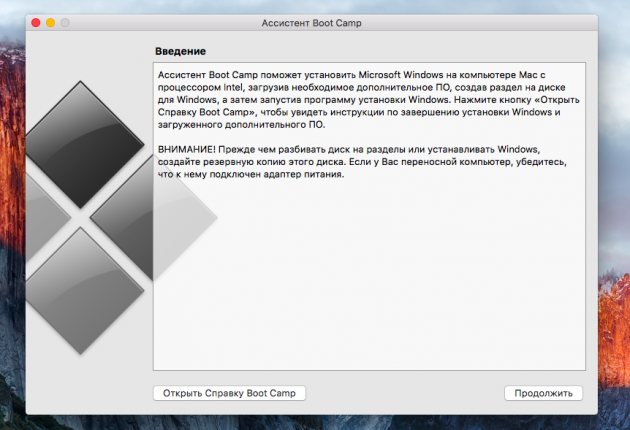
Вам потребуются 50 ГБ свободного места и загрузочный диск Windows. Сам процесс установки очень прост, нужно лишь следовать подсказкам мастера и дождаться завершения. После перезагрузки вы получите в своё распоряжение полноценную версию Windows, как на обычном ПК. Останется установить необходимые приложения или игры — и можно пользоваться. Подробнее о требованиях и поддерживаемых версиях можно узнать здесь.
- Производительность. Поскольку все ресурсы Mac использует только одна ОС, мы получаем максимальное быстродействие.
- Совместимость. Благодаря полноценной Windows обеспечивается полная совместимость с любыми приложениями и играми.
- Необходимость перезагрузки. Для запуска Windows всякий раз придётся перезагружать Mac.
- Отсутствие интеграции. Windows не поддерживает файловую систему HFS+, а значит, получить из неё доступ к файлам OS X будет нельзя, равно как и наоборот.
Использование виртуальных машин
Этот способ имеет много общего с предыдущим, но немного отличается в реализации. С ним мы также получаем полноценную ОС, но устанавливается она не на реальное «железо», а на виртуальное. Специальное ПО (виртуальная машина) эмулирует аппаратную платформу для запуска Windows, отбирая часть ресурсов Mac, и получается, что одна ОС работает внутри другой.
Существует несколько виртуальных машин, как платных, так и бесплатных. По принципу работы они аналогичны, а отличия незначительны и больше заключаются в функциональных возможностях. Windows устанавливается из образа загрузочного диска или физического носителя. Выбираем количество ресурсов, которыми вы готовы поделиться с гостевой ОС (процессор, память, дисковое пространство), а дальше как обычно устанавливаем Windows и нужные приложения и используем в оконном или полноэкранном режиме, в любой момент переключаясь между OS X и Windows.
Parallels Desktop
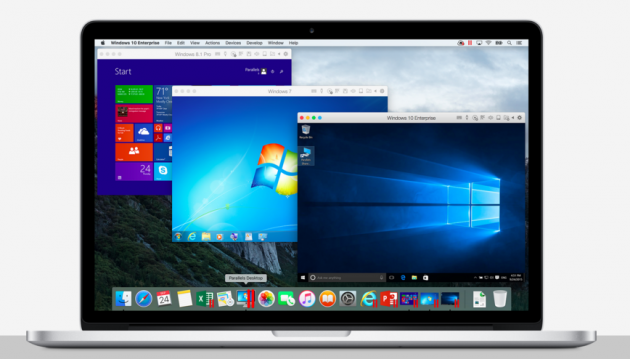
Пожалуй, самая популярная среди «маководов» виртуальная машина. Parallels регулярно обновляется, всегда работает с актуальными версиями OS X и Windows и обладает дополнительными функциями вроде гибридного режима, когда на экране одновременно отображаются интерфейсы OS X и Windows, а приложения запускаются независимо от их принадлежности. Кроме того, программа умеет запускать Windows из разделов Boot Camp, что удобно, если нужно получить доступ к каким-либо приложениям или данным без перезагрузки.
Недостаток программы заключается в том, что Parallels не бесплатна. Младшая версия обойдётся вам в 79,99 доллара.
VMware Fusion
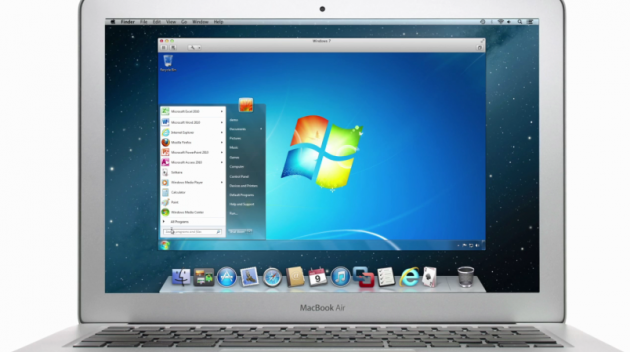
Ещё одно коммерческое решение для виртуализации ОС. Ключевой фишкой VMware Fusion является мастер обмена, позволяющий перенести всю среду с вашего Windows-ПК в виртуальную машину и продолжить использование приложений уже на Mac. Установленная Windows имеет общий с OS X буфер обмена, а также доступ к файлам и сетевым ресурсам. Её приложения полностью интегрируются с функциями OS X (Spotlight, Mission Control, Exposé). Кроме того, поддерживается запуск Windows из раздела Boot Camp.
VMware Fusion стоит 6 300 рублей, но перед покупкой вы можете изучить её возможности в бесплатной пробной версии.
VirtualBox
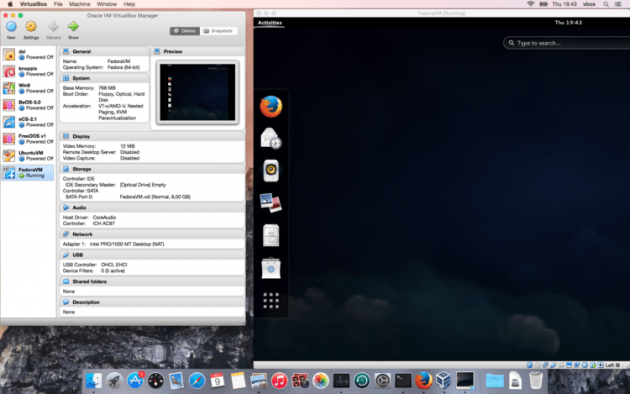
Если в ваши планы не входят дополнительные траты на запуск Windows-приложений, то ваш выбор — VirtualBox от Oracle. По сравнению с платными аналогами она обладает гораздо меньшими возможностями, но для простых задач вполне годится. На интеграцию с системными функциями OS X рассчитывать не стоит, но базовые вещи вроде общего буфера обмена и доступа к сетевым ресурсам здесь доступны. Бесплатность VirtualBox полностью оправдывает все её ограничения.
- Одновременная работа двух ОС. Для запуска Windows-приложений не нужно перезагружать Mac.
- Общий доступ к файлам. Поскольку Windows работает внутри OS X, проблема с поддержкой файловых систем отсутствует.
- Низкая производительность. Из-за того, что ресурсы Mac делятся между двумя ОС, быстродействие приложений значительно ниже, особенно на не самых новых компьютерах.
- Проблемы совместимости. Некоторые приложения (чаще всего игры), требующие прямого доступа к «железу», могут работать некорректно или не работать вовсе.
Использование эмуляторов
С эмуляторами всё совсем иначе, нежели с виртуальными машинами и Boot Camp. Вернее, у них есть что-то общее с виртуальными машинами, только эмулируют они не Windows целиком, а лишь те её программные компоненты, которые необходимы для работы нужного приложения. Полноценной ОС и доступа к её функциям у нас не будет: мы получаем некий слой совместимости, позволяющий запустить Windows-приложение прямо в среде OS X.
Все эмуляторы работают по одному и тому же принципу. Инициализируется установка приложения через setup.exe, а далее в её процессе настраиваются необходимые параметры запуска и автоматически загружаются нужные библиотеки. После этого на Launchpad появляется иконка приложения, которое будет работать так же, как и все нативные программы OS X.
WineBottler
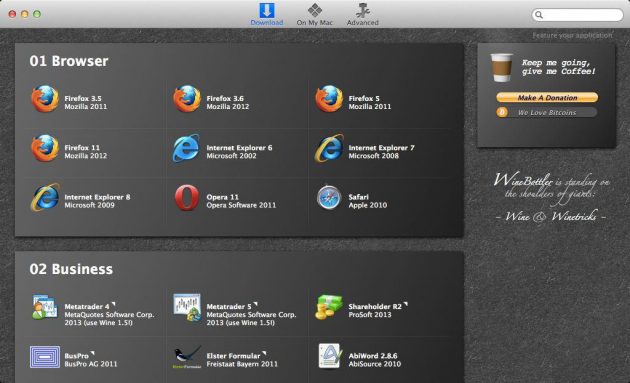
Этот эмулятор может превратить .EXE-файл в совместимое с OS X приложение. Также WineBottler позволяет автоматически загружать некоторые уже настроенные Windows-приложения. Он полностью бесплатен и совместим с OS X El Capitan.
Wineskin
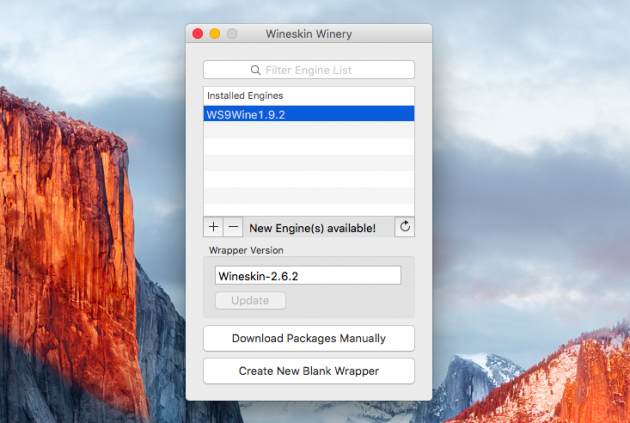
Ещё один эмулятор, который, как и предыдущий, использует библиотеки Wine для создания портов. По сравнению с предыдущим решением, Wineskin имеет больше настроек и позволяет более тонко задать параметры. Подробно о его настройке и использовании мы рассказывали в отдельной статье.
CrossOver
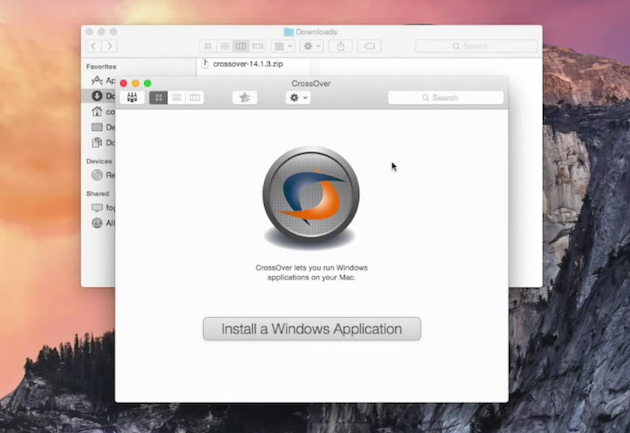
Коммерческий эмулятор, команда разработчиков которого уже адаптировала и настроила для вас множество популярных Windows-приложений и игр. CrossOver обладает дружелюбным интерфейсом, а также избавляет от необходимости копаться в настройках и разбираться с возможными ошибками. Единственный минус — он платный. Лицензия стоит 20,95 доллара, но есть 14-дневный пробный период.
- Не нужна лицензия Windows. Эмуляторы запускают приложения через слой совместимости, поэтому лицензионная копия ОС не нужна.
- Производительность. Опять же, из-за экономии ресурсов, которые в виртуальных машинах расходуются на запуск полноценной Windows, мы получаем более высокую производительность по сравнению с ними.
- Сложность настройки. Для использования Windows-приложений их сначала нужно настроить, а это далеко не всегда бывает просто, особенно с играми.
- Проблемы совместимости. В некоторых случаях приложения (чаще ресурсоёмкие) могут работать неправильно или не работать совсем.
Что выбрать
Что же в итоге выбрать из такого многообразия? Однозначного ответа на этот вопрос нет. В каждом конкретном случае нужно отталкиваться от ваших нужд, но в целом рекомендации следующие.
- Boot Camp подойдёт в первую очередь геймерам, а также тем пользователям, которым нужна максимальная производительность и совместимость с софтом. Перезагружаем Mac — и получаем полноценный компьютер с Windows.
- Виртуальные машины выручат в случаях, когда нужны обе ОС одновременно. Жертвуем производительностью, но избегаем перезагрузок и получаем хорошую интеграцию.
- Эмуляторы можно порекомендовать только для несложных задач и нечастого использования. Например, когда пару раз в месяц вам нужно воспользоваться банк-клиентом или изредка поностальгировать в любимой игре.
Выбирайте для себя самый подходящий вариант, а в комментариях рассказывайте, для каких нужд вы используете Windows-приложения на своём Mac и как их запускаете.
Windows emulators allow users to run Windows software and applications on non-Windows systems like macOS, Android, or Linux. This is especially valuable for developers, gamers, and professionals who depend on Windows-exclusive programs. However, finding the right emulator can be challenging—some are slow, lack critical features, or require complicated setups. With so many options available, how do you choose the best one for your needs? In this guide, we’ll explore the top five Windows emulators, each carefully selected for different platforms and use cases. Whether you’re a Mac user, an Android tester, or a Linux enthusiast, there’s a perfect solution waiting for you.
Part 1: Parallels Desktop — Best Windows Emulator for Mac Users
Parallels Desktop is a premium virtualization tool built specifically for macOS users.
It allows you to run a full Windows environment alongside your Mac apps without rebooting. The software offers seamless file sharing, Coherence Mode, and Apple Silicon optimization. Its one-click setup makes it easy even for beginners to get started. Parallels are ideal for anyone needing smooth, high-performance Windows access on a Mac.
Features:
-
Seamless file sharing between Mac and Windows
-
Coherence Mode to use Windows apps like native Mac apps
-
Optimization for Apple Silicon (M1/M2)
-
One-click setup for Windows
Pros:
-
Superb performance
-
Easy for beginners
-
Regular updates and support
Cons:
-
Paid subscription required
-
Resource-heavy on older Macs
Writer Insight:
When running MS Access and Windows-exclusive IDEs like Visual Studio via Parallels, the experience felt almost native. Coherence Mode made it feel like I was using Mac apps, without any significant lag—a true game-changer for cross-platform productivity.
Part 2: Wine — Best Free Open-Source Windows Emulator for Linux and macOS
Wine is a free, open-source compatibility layer that lets you run Windows applications on Linux and macOS. Unlike traditional emulators, it doesn’t require a full Windows installation. It translates Windows system calls into POSIX-compliant calls in real-time.
Wine is lightweight, efficient, and ideal for running many popular Windows programs.
It’s perfect for users who want a simple solution without setting up a virtual machine.
Features:
-
Lightweight and free
-
No Windows license needed
-
Strong community support
-
Frequent compatibility updates
Pros:
-
Completely free and open-source
-
No need for virtual machines
-
Low system resource usage
Cons:
-
Complex for beginners
-
Not all apps run flawlessly
Writer Insight:
I once used Wine to run a small Windows-only utility on Ubuntu. The installation required some tweaking, but the app ran smoothly once set up—almost indistinguishable from a native Linux program.
Part 3: Boot Camp — Best Native Dual-Boot Windows Emulator for Intel Macs
Boot Camp Assistant is a built-in macOS utility that allows Intel-based Mac users to install Windows directly on their hard drives. Unlike virtualization, Boot Camp creates a native dual-boot setup, giving Windows full access to the Mac’s hardware resources. This means you can enjoy maximum performance when running Windows applications, games, or intensive software. It’s an ideal solution for users who need the full power of Windows without the compromises of emulation or virtualization.
Features:
-
Dual-boot into Windows or macOS
-
Full Windows compatibility
-
Ideal for gaming or heavy software use
Pros:
-
No virtualization overhead
-
Full system resource access to Windows
-
Great for high-performance apps
Cons:
-
Only works on Intel Macs
-
Requires rebooting to switch OS
Writer Insight:
Switching between macOS and Windows via Boot Camp felt like having two powerful laptops in one. Although rebooting added a few extra minutes, the raw performance for gaming and video editing was worth it.
Part 4: BlueStacks — Best Windows Emulator for Android Game Access
BlueStacks, originally famous for running Android apps on PCs, has expanded its capabilities to offer access to select Windows games and productivity tools through cloud streaming on Android devices. This means users can enjoy lightweight Windows experiences without needing a full desktop setup, making it ideal for casual gaming and light app usage on the go. BlueStacks integrates keyboard, mouse, and controller support, ensuring smooth gameplay and better usability.
Features:
-
Runs on Android with Windows functionality via cloud
-
Offers keyboard/mouse compatibility
-
Sync with desktop setups
-
Built-in store access
Pros:
-
Lightweight, cloud-powered
-
Great for casual Windows use
-
Free to use
Cons:
-
Limited full app compatibility
-
Mostly suited for gaming
Writer Insight:
Using BlueStacks on my Android tablet to stream a light Windows game was smoother than expected. Controls were responsive, and the interface felt intuitive even for first-time users.
Part 5: VMware Workstation Player — Best Cross-Platform Windows Emulator for Linux and Windows
VMware Workstation Player is a professional-grade virtualization tool designed for users who need to create and manage virtual machines on Linux and Windows systems. It allows you to run a fully functional Windows environment alongside your primary OS without needing a separate physical machine. The software supports advanced features like snapshots, USB passthrough, and hardware acceleration, ensuring stable and high-performance virtual environments.
Features:
-
Create and run multiple VMs
-
Snapshot & rollback features
-
Broad OS support
-
USB and hardware passthrough
Pros:
-
Professional-grade virtualization
-
Stable and secure
-
Free for personal use
Cons:
-
Less user-friendly than Parallels
-
Requires good hardware specs
Writer Insight:
Setting up VMware to run Windows 11 on Ubuntu was straightforward once I got the hang of it. Windows apps like Photoshop and MS Project ran at near-native speeds, but hardware resource management was key for smooth performance.
Part 6: Use WPS Office to Edit, Save, and Share Across Emulated Windows Environments
Why WPS Office Is the Perfect Companion for Windows Emulators?
Once you’ve set up your emulator and are running Windows apps, having a reliable, lightweight office suite becomes essential for daily productivity. That’s where WPS Office truly shines. Tailor-made to perform smoothly even in virtualized or emulated environments, WPS Office ensures you can open, edit, and save documents without the lag or heavy resource demands typical of larger suites like Microsoft Office.
Whether you’re running Windows through Parallels on a Mac, Wine on Linux, or VMware on Windows, WPS Office integrates seamlessly. It offers full compatibility with Word, Excel, Spreadsheets and PowerPoint file formats, so you won’t have to worry about formatting issues when moving between systems. Plus, the built-in PDF Editor, advanced formatting tools, and cloud sync options allow you to stay productive, organized, and mobile.
WPS Highlights:
-
Compatible with Wine, Parallels, VMware, and others
-
Full zoom and window management support
-
Built-in PDF Editor for documentation and reporting
-
WPS AI: Quickly summarize long documents
-
Cloud sync across Mac, Windows, Linux
Writer Insight:
Running WPS Office inside VMware was impressively fast. The PDF editing feature saved me time preparing reports, and the formatting tools worked perfectly without any layout glitches.
FAQs
Q1: Can I run all Windows software in an emulator?
A: Not all apps are fully compatible—some advanced or hardware-intensive apps may not work perfectly depending on the emulator.
Q2: What’s the difference between virtualization and emulation?
A: Emulation mimics hardware behavior, while virtualization uses your actual hardware more directly for better performance.
Q3: Is it legal to use Windows emulators?
A: Yes, as long as you have valid Windows licenses where required and follow local software laws.
Q4: Will using a Windows emulator slow down my system?
A: Some tools are lightweight (like Wine), while others (like Parallels or VMware) may require more memory and CPU. Performance varies.
Summary
Windows emulators make it possible to enjoy the flexibility and power of Windows software across a variety of platforms, including Mac, Android, and Linux. Whether you’re a developer needing a full Windows environment, a gamer looking to play PC titles on different devices, or a professional relying on Windows-exclusive applications, there’s a solution tailored to your needs. Tools like Parallels Desktop offer seamless experiences for Mac users, while VMware Workstation Player delivers robust virtualization for Linux and Windows systems. Even lighter options like Wine allow users to run Windows apps without the overhead of a full OS installation.
When it comes to maximizing productivity inside these emulated environments, WPS Office emerges as the perfect companion. Its lightweight design, compatibility across platforms, and powerful features like cloud sync and AI-powered document summarization make it an excellent choice for handling all your documents, spreadsheet, and presentation needs. Paired with the right emulator, WPS Office ensures your Windows experience—whether virtualized or emulated, remains fast, efficient, and truly productive.
Summary: If you are eager to run that popular Windows app on your MacBook, then you should definitely consider taking the help of a Windows Emulator App. In this article, we’ll review some of the Best PC Emulator Software (2024) to simulate a Windows environment on your macOS.
Most Windows users wish to replace their Operating System with a macOS one. But they are not alone, sometimes even Mac users wish to experience certain Windows software & programs on their machine. If you are sick of limitations to toggle between Windows & Mac as needed, try using Top Notch Windows Emulator Tools For Mac (2024).
What is a Windows emulator and why is it necessary?
A Windows emulator is a software that allows a computer to run on a non-Windows operating system, such as macOS or Linux. Essentially, the emulator creates a virtual environment that simulates the Windows OS & Settings, so that the non-Windows computer can run those OS-specific apps as if it was a Windows PC. Cool, right?
Windows emulators work by translating the commands and processes used by Windows software into a language that can be understood by the host operating system. People use Windows emulators for all sorts of things, like work, gaming, and running specialized software for trying & testing.
There are a bunch of different emulators out there, free and paid, each with its own quirks and features.
You Might Want To Read: How To Remotely Access Any Machine Using Chrome?
6 Best Windows Emulator For Mac (2024)
To start running Windows on Mac, these are the best options you can consider using:
1. Boot Camp
Well, Boot Camp comes pre-installed with all Macs and it is a reliable tool that assists users to experience Windows Operating System on macOS. It even presents an excellent ‘dual-boot’ mode that lets users install both Windows and Mac on two different partitions. As soon as you switch on your Mac, you’ll be asked whether you would like to enter in Windows or macOS. Moreover, it is worthy to mention the fact, the Boot Camp is compatible with Intel machines only. To know more about the utility at Apple Support Page!
HIGHLIGHTS:
- Customizable Touch Bar for adding Windows-specific features.
- Improved Graphics Performance for gaming and graphics-intensive apps.
- Windows Precision Touchpad Support for a better touchpad experience on Macs.
- Improved Audio Driver for better audio quality and compatibility with Windows apps.
Pros
- Built in for Mac working on Intel
- Access Windows games on Mac.
- Setup and usage is easy.
Cons
- Not available for latest Mac models.
NOTE: With Apple’s transition to the M1 processor in 2020, the company decided to not develop Boot Camp for the M-series Macs. Currently, it is compatible with Intel machines only!
Price: Free
Try Boot Camp Today!

Why Should You Use Boot Camp? = Comes pre-installed on your Mac, you don’t need to install any additional tools on your machine to run Windows OS.
2. Virtual Box
Virtual Box is an open-source and free Windows emulator available for both home and enterprise users. In fact, it can be operated not only on Mac but it does support a variety of other operating systems like Linux, Windows, etc. It ensures that you can run Windows programs or the entire operating system just like any other app without making significant alterations in the configuration of the system. Just ensure, while you are downloading this best Windows Emulator, you have at least 8 GB of free disk space.
HIGHLIGHTS:
- Supports nested virtualization on Intel processors.
- Has improved CPU, memory, disk access, and graphics performance.
- Has better 3D acceleration and multi-monitor support.
- Supports IPv6, PXE boot, and jumbo frames.
Pros
- Easily runs Windows games & apps.
- Free for Home users & students.
- Does not require a reboot.
Cons
- Lacks advanced features.
Price: Free for Home Users, $50/User for Perpetual User License & $1000/Socket for Perpetual Socket License.
Try Virtual Box Today!

Why Should You Use Virtual Box? = It’s an open-source tool, which means it is free to use for individuals
3. Parallels Desktop
Well, Parallels Desktop is one of the most popular and best Windows emulators for Mac available today. It allows you to run multiple guest operating systems such as Windows, Chrome OS, DOS, Ubuntu, Debian, Leopard, macOS X, and Debian. Additionally, it includes handy file archiving features and drives cleanup tools to provide a seamless experience while running Windows programs on Mac.
HIGHLIGHTS:
- Allows users to launch Windows apps from the dock.
- Comes with a Travel Mode to extend the battery life.
- Allows users to view the overall resource usage.
- Supports One-Click tuning.
Pros
- Fast speed.
- Does not require rebooting Mac.
- Launch apps using Taskbar.
Cons
- Not available for all macOS versions.
Price: $74.99 for Standard Edition (Suitable for Home & Students), $89.99 for Pro Edition (Suitable for Developers, Testers & Power Users), $112.49 for Business Edition (For Teams & IT Deployments).
Try Parallels Desktop Today!

Why Should You Use Parallels Desktop? = It works at a fast rate and you don’t need to reboot to implement the changes.
4. Wine
If you are some who operates on older versions of Mac but wishes to experience the newest versions of Windows applications, Wine is the ultimate solution for you. Although, you’ll be able to enjoy only one or two Windows programs consecutively while using the Windows emulator. Apart from this, it is also important to note that Wine doesn’t support running the entire Windows OS on your Mac as a virtual machine. Similar to Virtual Box, Wine Windows emulator for Mac is available for free of cost and can be downloaded without spending a single penny.
HIGHLIGHTS:
- Open-source and free emulator with no licensing costs.
- Capable of running Windows apps on Unix-like OS, including Linux, macOS & BSD.
- Supports a broad range of Windows apps, including Microsoft Office & Adobe Photoshop.
- Receives regular updates and bug fixes for improved performance & compatibility.
Pros
- Lightweight software.
- Freeware.
- Updated timely.
Price: Free
Try Wine Windows Emulator Today!

Why Should You Use Wine Windows Emulator? = If you are looking for a tool that only runs Windows apps.
5. CrossOver
CrossOver, designed & developed by CodeWeavers is a paid Windows emulator for Mac. It’s an open-source application and doesn’t support running a virtual machine on your Mac. In addition to this, users don’t need to get a Windows license to operate seamlessly. Using CrossOver, you can effortlessly run numerous Windows apps alongside Mac applications without rebooting your device. The Windows emulator offers a free trial so that you can utilize the program before purchasing.
HIGHLIGHTS:
- Fixed the memory issues on Ventura.
- Hassle-free installation, setup & usage process.
- Stable and reliable performance with smooth macOS integration.
- Improved compatibility for running Windows apps on Linux & Chrome OS.
Pros
- Runs without Windows license.
- Good user interface.
- Supports a number of apps and games.
Cons
- Limited features in the free version.
Price: Free Trial, Starts at $59.95
Try CrossOver Today!

Why Should You Use CrossOver? = Supports running a variety of popular Windows applications and games without any hiccups.
6. VMWare Fusion
Our list of Best Windows Emulators for Mac is concluded by VMWare Fusion. Unlike most of the software mentioned here, VMWare Fusion allows users to run Windows in full-screen so that your Mac feels like a PC. It even allows you to run individual Windows software parallel to Mac apps so that you can make the most out of your machine. This Windows emulator works quite similarly to Parallels Desktop, the only difference is – – Parallels is authorized on each Mac premise while Fusion on the other hand is authorized per client.
HIGHLIGHTS:
- New Guest OS support – Windows 11, Windows Server 2022, RHEL 9,
- Now supports running Arm virtual machines on Apple Silicon Macs.
- Choose between security (Full) and performance (Fast) options for encryption.
- Improved Graphics Support OpenGL 4.3 for Windows & Linux on Intel Macs as well as in Linux arm64 virtual machines on Apple Silicon Macs.
Pros
- Supports Touch Bar functionality.
- Mac apps can run in the background.
- Easily access Mac and Windows together.
Cons
- Can make your Mac slow.
Price: $79.99 for the Standard version, $119.99 for the Pro version
Try VMWare Fusion Today!

Why Should You Use VMWare Fusion? = Because you get the ability to run more types of operating systems other than Windows.
If you are eager to learn about the Best Virtualization Software for Windows, click here!
Frequently Asked Questions: Best Windows Emulators For Mac (2024)
Q1. When To Use An Emulator?
Well, emulators are often used by developers & product testers to check how a specific software interacts with underlying hardware or a blend of hardware & software. Users who wish to know whether a firmware update will result in problems for your programs should use an Emulator to find that.
Q2. Is It Safe To Use Emulators?
Emulator solutions are generally quite safe. However, you need to be vigilant about the source of downloading the emulator. If you consider installing the program from reputed and trustworthy sources, your device is cent percent safe!
Q3. What Emulators Work On Mac?
There are a variety of options available when it comes to choosing the Best Mac Emulator Software — — Microsoft Virtual PC for Mac, XBOX 360 Emulator for Mac, DosBox, OpenEmu, and so on.
Q4.What Does a PC Emulator Offer for macOS?
PC Emulation Software allows users to simulate a Windows environment on their macOS. The application comprehensively addresses the original hardware/software environment (this includes access to your OS & installed apps) and recreates it on your current machine.
Wrapping Up Our List Of Best Windows Emulator Software For Mac (2024)
Emulation is a process of simulating another kind of device on your current machine. The technique is more cost-effective as compared to virtualization and holds the potential to reproduce the behavior of the same hardware on your computer. With that being said, all the aforementioned PC Emulators will help you handle most Windows apps on your Mac with ease. I would personally recommend Virtual Box as it has the latest AMD and Intel hardware support, allowing you to have fast execution times.
Are you in a situation where you really want to use an app on your Mac, but it’s only available for Windows? Don’t worry! You can easily run Windows apps on your Mac using Windows emulators.
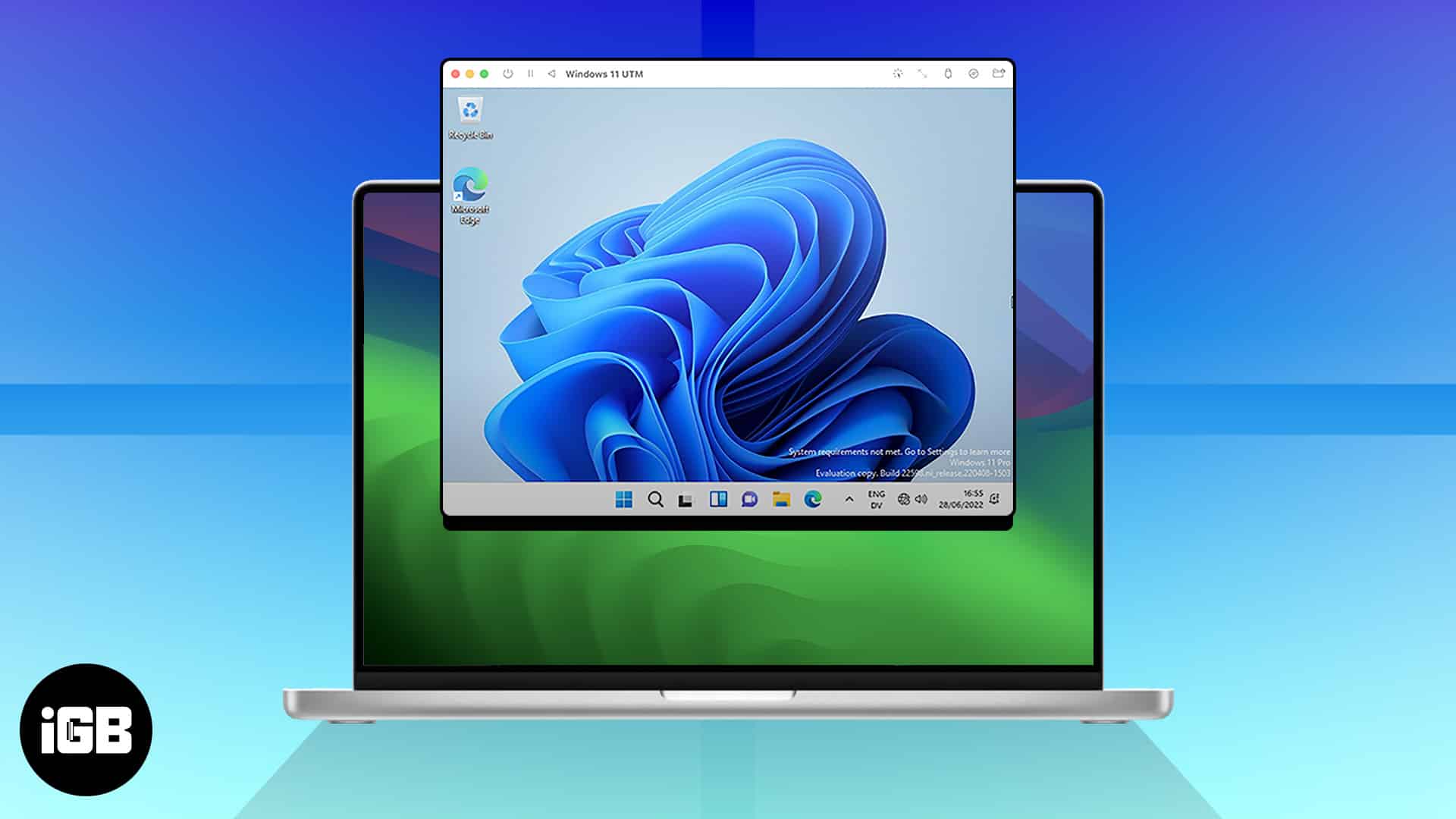
To make your life easier, I’ve compiled a list of the best Windows emulators for Mac. So, you can seamlessly experience the Mac-Windows environment on your MacBook.
Become an iOS 18 Master:
Get our exclusive iOS 18 eBook 📚 for FREE when you sign up for our newsletter below.
What is a Windows emulator?
A Windows emulator is an application that lets you run the Windows OS, including its graphical user interface (GUI) and Windows-based apps, on another computer that doesn’t natively use Windows, such as Linux or Mac.
When you install a Windows emulator on your Mac, you can switch between the macOS and Windows environments. It allows you to use Windows virtually, pretending to be native software on your Mac. Again, when you return to macOS, you can not trace Windows.
Switching to Windows using an emulator doesn’t affect your Mac’s RAM, as you may think. However, installing Windows apps via an emulator can eat up your Mac’s disk space since all installed apps on either platform are on the hard drive.
Real Recommendations by Real Experts: Why you can trust iGeeksBlog?
At iGeeksBlog, we pride ourselves on having over 13 years of experience in all things Apple. We understand how apps and software can make or break your experience of Apple devices. That’s why our experts go the extra mile to personally use, test, and assess every app and software we recommend. We are committed to ensuring you only use safe and truly useful apps that help you make the most of your Apple devices. To learn more, read about our testing and editorial processes.
What are the best Windows emulators for Mac?
Let’s quickly review some of the best Windows emulators to help you run Windows on Mac. There are various free and paid emulators available.
1. Parallels Desktop
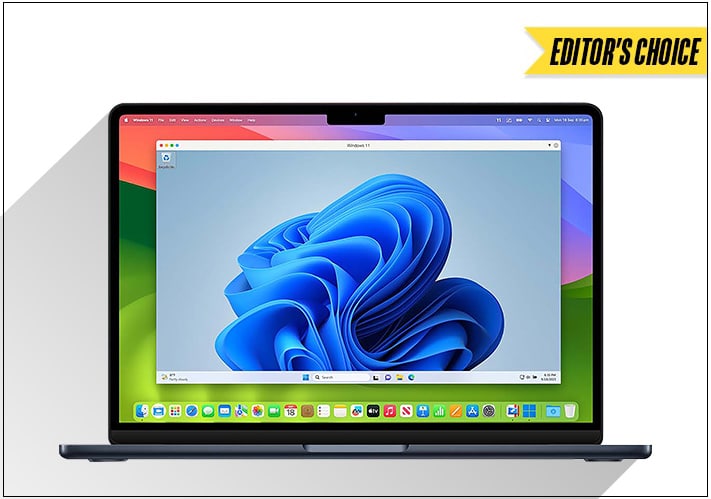
Parallels Desktop is now back and better with the recent build. The platform lets you install and run Windows 11 alongside Mac without a hassle. The installation is very straightforward, as you don’t have to boot your device into separate environments.
Simply toggle the Windows icon to open the Windows 11 environment on one side of the screen, or use Windows 11 in full-screen mode for a better experience. Besides, Parallels Desktop provides a dedicated Windows 11 environment.
You can run Windows video games on a Mac like you’re on a computer that runs Windows natively. A unique feature of this Windows emulator for Mac is that you can easily drag folders and files, including videos and photos, between the Windows and Mac environments.
Pros
- Drag folders and files between Mac and Windows environments
- Supports Intel and Apple Silicon processors
- Support for Windows 11 ARM
- Dual-booting not required
Cons
- Windows bloating might slow down the app with prolonged usage
2. Boot Camp Assistant – Built-in emulation method
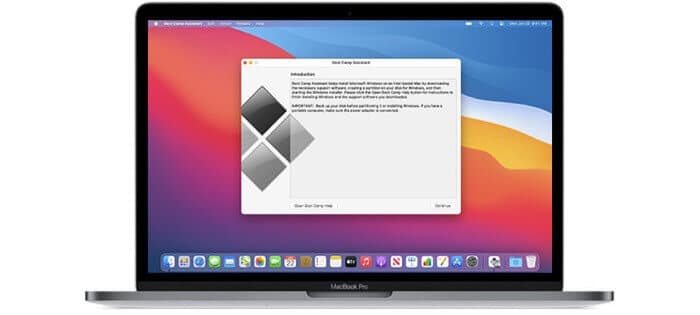
I wouldn’t call Boot Camp Assistant a 100 percent emulator, as it involves some form of resource sharing. But it’s the best way to install Windows 10 on your Mac using a built-in method. You can find Boot Camp Assistant in the Utilities section of your Mac’s Applications folder.
However, as of this writing, the Boot Camp feature is only limited to Intel-based processors. So, if you own an Apple Silicon Mac, you might want to look elsewhere. You won’t find Boot Camp Assistant on those Macs.
You need at least 64GB of hard disk space on your Intel-based Mac to successfully install and run Boot Camp Assistant. Keeping extra space is better, though. When tested on my Mac, the emulator performed better when I offloaded about 100GB of disk space.
A challenge you might face with Boot Camp Assistant is its technical installation process. You’ll have to download a Windows 10 ISO image file from Microsoft onto an empty flash drive (with at least 16GB storage capacity).
Once downloaded, Boot Camp Assistant will guide you through the process. Another setback is that you’ll have to reboot your computer to switch between both platforms.
Pros
- Built-in method without app installation
- Separation of the host machine from the guest machine keeps a focus on an OS
- Best for running resource-intensive Windows applications, including games and graphic design software
Cons
- Not recommended if you want to avoid dual-booting
- Windows installation can be technical without prior installation experience
3. Wine – Open-source and free

Wine is handy if you only need to run one or two Windows apps on your Mac. It’s similar to Crossover in operation, but it’s open-source, and I recommend it for older Mac versions.
Instead of a dedicated space for Windows, it serves as an intermediary environment for Windows. It translates Windows-specific API calls into a set of compatibility standards called portable operating system interface (POSIX), eliminating the need to install Windows directly onto Mac.
Wine is available for free. Whether using a new or older Mac OS version, there are plenty of unofficial versions you can bank on. One caveat for M1, M2, and M3 users is that they may need to consider alternatives, as Wine doesn’t work on Apple Silicon.
Pros
- Windows installation is not required
- Open-source and free alternative to Crossover
- Best for older Mac OS versions
Cons
- It doesn’t support Apple Silicon processors as of writing
4. VMware Fusion – Emulate many Windows versions
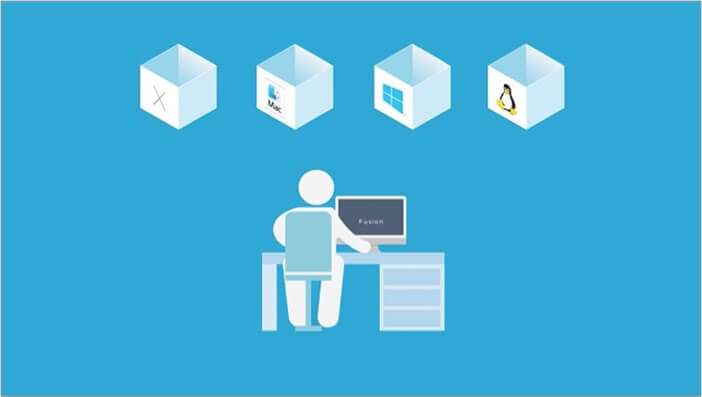
VMware Fusion has been around for close to a decade. And it’s even better with Fusion 13. One of its winning attributes is its stability and unwavering support for Windows virtualization. However, note that VMware Fusion is costlier than the emulators recommended earlier.
Overall, VMware Fusion provides one of the most suitable environments for developers who run their projects on multiple devices, as it supports Linux and many other OS. Besides, with support for the Windows 11 ARM ISO, installing Windows 11 on Mac is never easier.
A unique feature is that you can install many versions of Windows into the virtual machine library and switch between them easily. With support for all processor types, including Intel, M1, and M2 Macs, you can use Windows at scale without rebooting to switch environments.
VMware Fusion also lets you install Windows in a virtual hard drive from an installation disk with a few clicks. While installing the Windows virtual machine via Fusion, you don’t need to worry about partition detection. It automatically syncs with Boot Camp’s partition.
Pros
- Full support for Windows 11 ARM
- Compatible with Intel and Apple Silicon processors
- Windows installation is straightforward
- Automatic partitioning available
- Switch between virtual machines easily
Cons
- It’s costlier than most emulator software
5. Crossover for Mac – No Windows license required
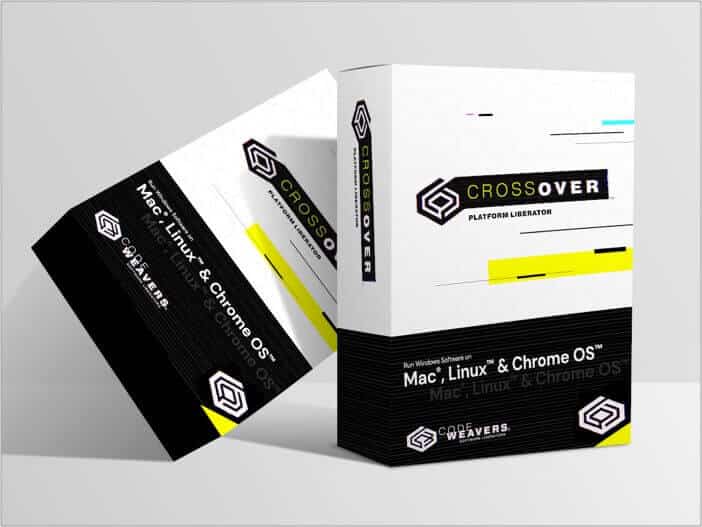
I strongly recommend Crossover for Mac if you want to avoid the technicalities of Boot Camp. Developed by CodeWeavers, Crossover offers a simple way to run Windows apps without rebooting or purchasing a Windows license.
Crossover doesn’t identify as a Windows emulator, but that’s precisely what it is. It provides a platform to run Windows applications on Mac. Although not free, you can start using Crossover’s 2-week free trial. And what’s more? It doesn’t require your credit card details.
Crossover works on Intel-based and Apple Silicon processors. Instead of a dedicated Windows environment, you get an interface where you can install and run Windows apps with a tinge of nativity. Installation is easy and doesn’t require setting partitions or downloading ISO images.
Pros
- No partitioning or technical Windows installation is required
- Run Windows apps directly without consuming extra OS installation resources
- Free trial with credit card available
- The paid version is available as a one-off license purchase
- Support for Intel and Apple Silicon Macs
Cons
- Only suitable for running a few Windows apps
6. VirtualBox – Run a Virtual Windows alongside Mac

VirtualBox lets you run Windows 10 below as a virtual machine with an allocated resource on Mac for free. This way, you can separate the host OS (Mac) from the guest OS (Windows). Surprisingly, VirtualBox doesn’t require you to dual-boot to switch between OSes.
It provides a platform to run Windows directly over your Mac OS without compromising allocated resources such as RAM and disk space. However, it’s not a Windows 11 ARM hypervisor, which means you can’t install a Windows 11 ISO using VirtualBox.
After creating a virtual machine, you’ll need to download a Windows ISO and load it directly into it to get Windows on your Mac. What I admire about VirtualBox is that you don’t need to load a Windows ISO from an external drive.
The process is seamless as it offers simple onscreen instructions. Switching to a Mac-only environment is easy; simply shut down Windows and close the VirtualBox.
Pros
- Run a virtual machine without dual-booting your device
- Switch between Mac and Windows easily
- Free option to emulate Windows on Mac
- Support for Intel and Apple Silicon Macs
- Resource allocation is straightforward
Cons
- It doesn’t support Windows 11 ARM
- The whole process can be a bit technical without prior experience with virtual machines
Winding up…
Mac is undoubtedly a powerful machine with many valuable built-in apps and room for third-party apps. But creating a dedicated space to run Windows apps on your MacBook extends its usability and saves cost – especially if you love portability.
As you’ve seen, each emulator has its pros and cons. So, choose what works best for you. Have you installed one of these? Share your experience in the comments section.
Also Read:
- Best Android emulators for Mac
- How to use Delta emulator on iPhone to play Nintendo games
- Best SNES Emulators for Mac
Become an iOS 18 Master:
Get our exclusive iOS 18 eBook 📚 for FREE when you sign up for our newsletter below.
Table of Contents
If you are a Mac user but find yourself needing to run Windows applications, Windows emulators for Mac exist to bridge the gap. Running Windows software on a Mac can be essential for various reasons, and the best way to do this is to install a Windows emulator.
In this article, we’ll explore the top six Windows emulators available for your Mac..
What Does a PC Emulator Offer for macOS?
PC emulators can be powerful tools for your Apple computer. It is a program that enables the ability to run software from an entirely different device on your local system.
That means you can use a PC emulator to simulate a Windows environment on your macOS device.
FYI
Most people use PC emulators to play video games on their preferred operating system. With this structure in place, you can run apps and software that generally wouldn’t function on that computer.
Although this structure provides more versatility, an emulator also tends to slow macOS to a crawl unless you have some massive processing power. If you’re working with a pre-2010 Apple computer, this option might not be worth your time unless you’ve upgraded your RAM and internal storage.
How to Find the Best Windows Emulator for Mac
There are certainly numerous benefits to consider when operating a Windows emulator on a Mac. When you start looking for the best one to meet your needs, it is essential to find the one product that limits the potential risks of this program.
The biggest problem to manage is the speed of your system. Emulators must reproduce behaviors from an entirely different platform on your Mac. Since they don’t have a dedicated power source or hardware to accomplish this outcome, macOS slows considerably.
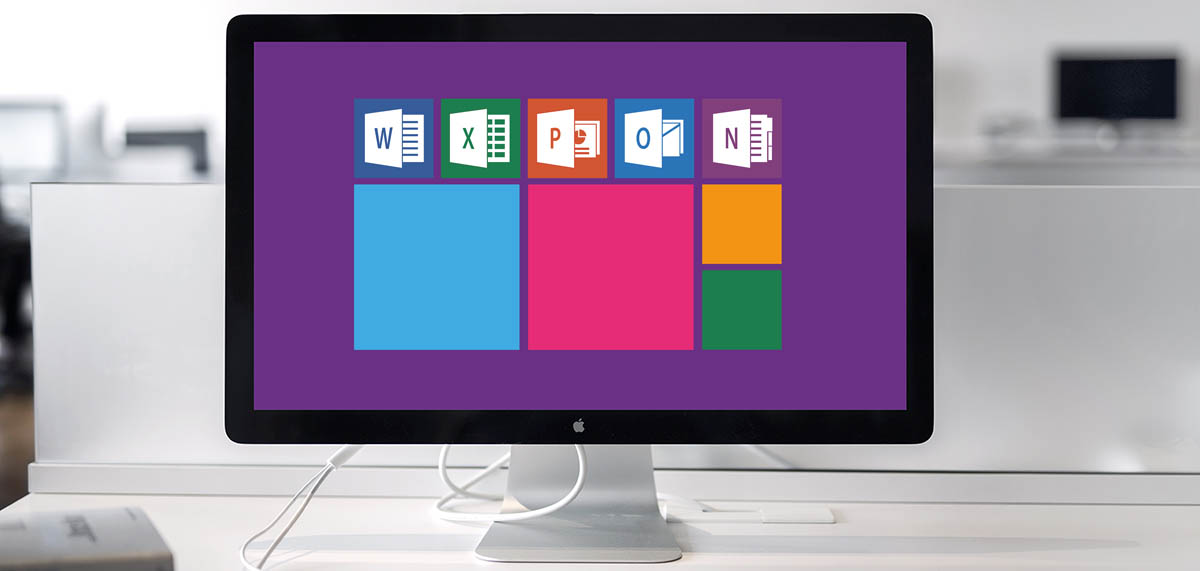
When you emulate older systems, this disadvantage typically disappears. You could emulate a first-gen Nintendo Entertainment System on virtually any Mac without a problem.
If you want to emulate Windows 10 to turn your Mac into a gaming computer, it’s a different conversation. Without the right memory, CPU, and graphics, it’s more challenging to achieve the desired result.
Three additional risks should get reviewed before you decide to download a Windows emulator for your Mac.
Disadvantages of Windows Emulators And How to Avoid Them
- The Windows emulator could be masquerading to encourage you to download a virus package instead – Your best option is to download one of the best Windows emulators for Mac that come from a trusted resource. Always do your research and perform your due diligence before installation.
- There could be legal consequences to your decision to operate an emulator on your Mac device – It is typically permissible to use an emulator in almost every jurisdiction, although there are occasional exceptions to that statement. If you download a program to use on one without the appropriate license, that’s when trouble often starts. You’ll want to review if and when an emulated program is usable.
- Your Mac might not operate Windows 10 as expected after installing your preferred emulator – If you’ve reviewed the installation process and everything checks out, the problem could be with your hardware. Since Windows 10 is a memory-intensive product in this structure, your iMac, MacBook Pro, or Mac Mini might need some upgrades.
When you can find a Windows emulator that avoids these potential issues while meeting your specific needs, you’ve found an excellent program.
What Are the Best Windows Emulators for Mac?
It doesn’t take long to find dozens of potential emulators listed for downloading. When you start investigating those links, you’ll quickly discover that some look rather suspicious.
Although we’ve thoroughly researched the five best Windows emulators for Mac, we strongly recommend that you take a trust-no-one approach to this download. With the potential for redirects and other issues that exist, you never know what might happen between when we wrote this guide, and you found the program you wanted.
1. VirtualBox
VirtualBox is the Windows emulator to use when you need simple and straightforward virtualization. It delivers an excellent resource for teaching, gaming, or productivity solutions without disrupting your typical workflow.
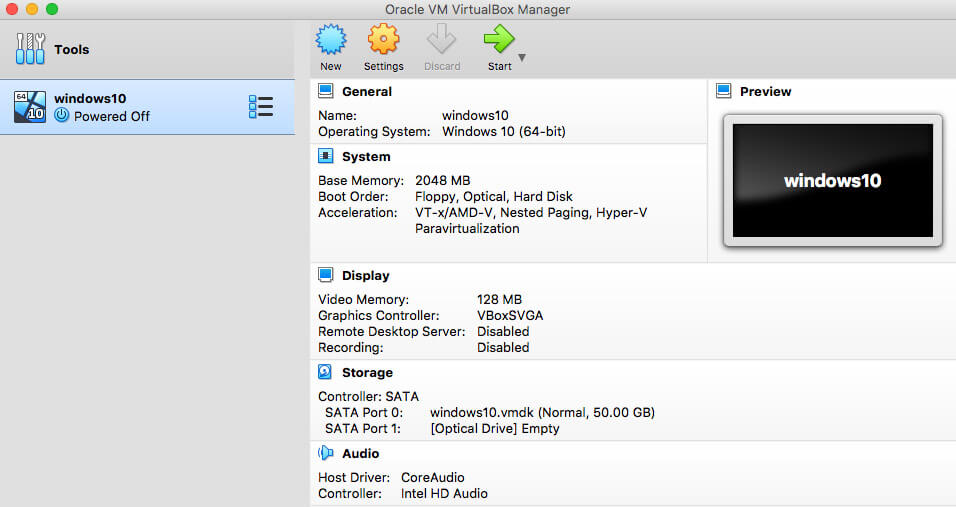
✅ Pros of Using VirtualBox:
- The program delivers a thoughtful interface that displays all of your virtual sessions, providing specific details for you to review when selected.
- With the service being an open-source product, it is available at no-cost and can get modified to meet your particular requirements without licensure expenses.
- It works to optimize your Mac’s resources to avoid slowing your system when using the Windows emulator for your software and apps.
⛔ Cons of Using VirtualBox:
- It can deliver an unpredictable speed performance for some macOS users, especially if the emulator gets installed on an older device.
- Since it is an open-source product, users must rely on a supportive community for help instead of having documentation available for troubleshooting.
- It would be helpful if the program came with a universal configuration tool so that you’re not stuck in a world of redundancy with every new virtual session.
We cannot ignore the potential cost savings that come with VirtualBox. Since it is an open-source solution, businesses could implement this resource across all teams to keep overhead expenses low. This program delivers a practical result that you can download and use immediately from a personal use view.
It also performs exceptionally well when used in a production environment. If you have multiple macOS versions operating across different devices, you can still use VirtualBox to meet your needs.
I use this as my daily currently. It’s definitely starting to show some age but it’s been exceptionally reliable.
To avoid restarting between OS’s I just use Virtualbox. Allows me to multitask between my other OSs easily
— Storm the IndyFurCon Gryph! (@StormGryphon) January 30, 2021
Although it sometimes struggles to provide an accurate processor reading, this issue can pop up occasionally. We also discovered that running one session doesn’t usually tax the system, but you’ll notice severe speed differences with multiple VMs operating.
You can find more information about Oracle’s VirtualBox by following this link: https://www.virtualbox.org/wiki/Downloads
2. Parallels Desktop
This Windows emulator is one of the most popular downloads of its type because it offers a consistent outcome. When using this program, you’ll find that transferring files between the host and virtualized desktop is almost effortless with the drag-and-drop or copy-paste functions provided.
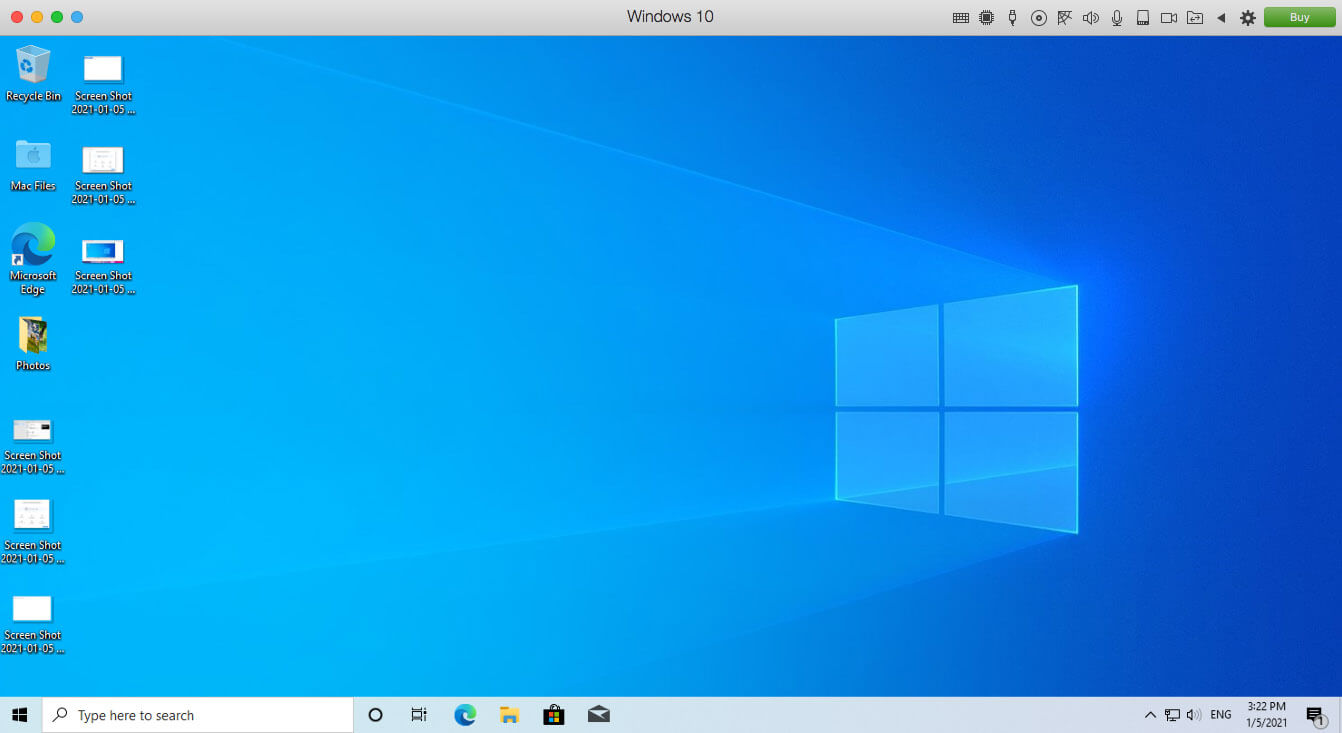
✅ Pros of Using Parallels:
- You have the option to configure the swipe gestures in macOS to switch between the host and virtualized desktop.
- It provides functionality from the Taskbar to let you launch your apps without going through multiple steps.
- The program’s coherence mode makes it easy for virtually everyone to take advantage of the benefits that a Windows emulator offers.
- You’ll receive intuitive Windows access while accessing legacy systems within a supportive and integrated environment.
⛔ Cons of Using Parallels:
- It isn’t available for all macOS versions. If you want to install Snow Leopard for your Mac, the option to use Parallels disappears. It has a server option that is quite expensive.
- Some of the games you can play with this emulator only operate at 20 frames per second. The current DirectX architecture isn’t fully supported.
- You must keep upgrading your software if you want to use the latest macOS version.
- The emulator uses a significant amount of memory, causing slowing on anything with less than 16 GB.
We appreciate the overall customer experience when working with Parallels Desktop. It provides comprehensive documentation, support websites, and approachable language. You don’t need to have a tech background to understand what you’re learning about with this emulator.
The primary benefit you’ll get with this program is its file transferring mechanism. It uses an intuitive approach that copies what you get on macOS already. If you know how to move a file from Finder to your desktop, you’re ready to transfer items from the virtual environment to the host.
I have the new 14″ MacBook Pro, and can say it is the best laptop I’ve ever had by a country mile. Can do all my trading on it with ease where ever I am. Also, if you need to run Windows for your trading client, @parallels has got you covered.
— Beluga Flow Trader (@BelugaFlowTrade) November 5, 2023
Pricing could be an obstacle for some users. Although you can download a free trial to explore its usefulness, the annual pro edition license is $99.99 per year. The same price applies to the business edition.
If you only need Parallels for home or classroom needs, you can save $20.
You can also buy the software outright as a one-time purchase, but this option doesn’t provide a free upgrade to a newer version.
More information about this Windows emulator for Mac is available at this link: https://www.parallels.com
3. VMware Fusion
With VMware Fusion, you can operate isolated software developmental environments relatively efficiently. Since you can do it all on a virtual disk image instead of setting up all potential variables on a local system, it’s much easier to switch between tasks without breaking anything or freezing the Mac.
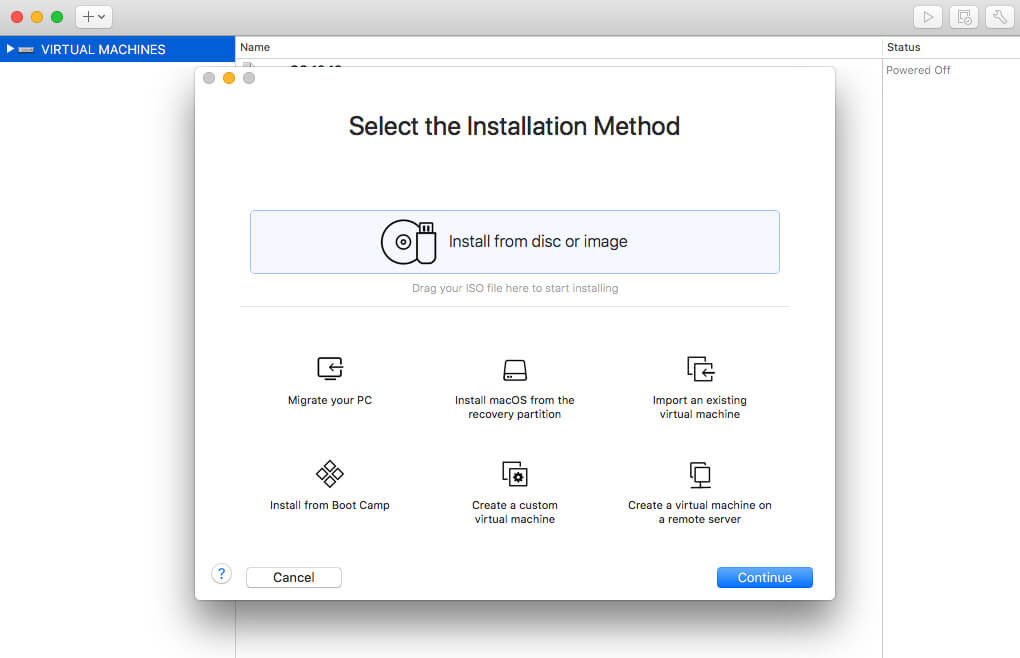
✅ Pros of VMware Fusion:
- You’ll receive an accelerated approach to using Windows apps on your Mac because of how it allocates system resources.
- It delivers an option to run a full version of Windows 10 on macOS so that you have access to both environments simultaneously.
- You have the option to copy and paste information from one operating system to the other to reduce the time it takes to transfer files and folders.
⛔ Cons of VMware Fusion:
- If you are using the Windows emulator, VMware doesn’t always recognize printers that you’ve set up through macOS, even if they are hardwired to the unit.
- You can sometimes lose your virtual environment’s Internet connection even though the Mac keeps it for the host.
- It provides below-average support for three-dimensional work or gaming needs.
We liked the way that VMware sets up when you run a PC emulator for Mac. You’ll go through a comprehensive process that takes you through each step for your preferred macOS installation.
Unless you’re performing 3D work with this emulator, you’ll find that it operates quickly without bogging down your system. It allocates resources in ways that don’t overload the CPU, even if you must simultaneously handle several tasks.
Man I left Parallels a long time ago. Hate their “discounts” that never work and pay by the year attitude. I switched to VMware Fusion and got a discount for switching. Lever looked back.
— TheRevenite (@TheRevenite) February 1, 2021
You’ll also get a better licensing system with your purchase since it allows for two Mac installations. It works better when you combine it with other VMware products, but you’ll find the overall benefits can help you stay more productive.
The cost for VMware is $149. If you upgrade to Workstation Pro™, the price is $199 for first-time users.
You can find more information about this emulator option by visiting this website: https://www.vmware.com
4. QEMU
QEMU functions as a virtualizer and emulator to ensure that you can operate virtually any operating system from your Mac. It uses a dynamic translation approach to ensure that you receive the functionality needed to run Windows on your macOS platform. This approach causes an almost-native outcome because it executes the guest code on your CPU.
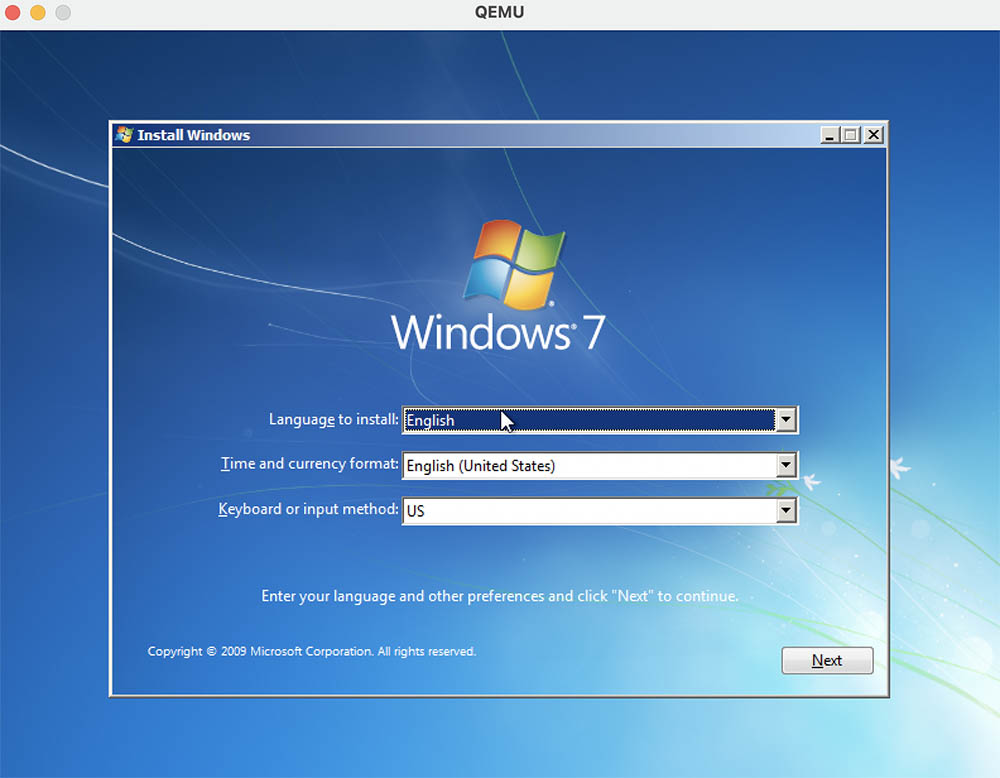
✅ Pros of QEMU:
- It offers an open-source approach to being a Windows emulator for Mac, giving you access without charge or patents being in the way.
- The structure of QEMU lets you emulate several CPUs simultaneously without dramatically impacting the system’s overall performance.
- It has an extensive community that supports the platform so that it keeps improving over time.
- You’ll receive a configurable, stable, and positive GUI with this program.
⛔ Cons of QEMU:
- Some of the program’s accelerator functions aren’t compatible with every macOS option you might be using.
- The emulation performance is not always positive, especially when running a complicated environment on an older Mac.
- It’s a smaller project than some of the other open-source mediums in this category, which means the support might not be available for what you need.
With the platform’s latest stable release (8.1.2) reaching the Internet on October 16, 2023, you’ve got an excellent free resource that provides full-system emulation. It also provides a user-mode feature that runs programs from another target or supported architecture to maximize your Mac’s versatility.
Run executables for other architectures using QEMU. Sure, some devices are inexpensive but you can also emulate for free! Here I am running a 32-bit ARM executable on my laptop with a 64-bit intel processor. pic.twitter.com/cYMFi45v2F
— int eighty (@int0x80) January 29, 2021
You’ll find a comprehensive set of guides available through QEMU to help you manage your troubleshooting needs. Although the information does require some tech knowledge, a little help from Google can help most people figure out the instructions.
QEMU might not be for the casual user. Although it isn’t necessarily difficult to learn how to use it, the features provided are more than what the average Mac user needs when first starting. For everyone else, you can take advantage of the ARM, SPARC, MIPS, and other supports instead of being limited to x86-32 or 64.
More information about QEMU is available here: https://www.qemu.org
5. WinOnX
WinOnX is based on the open-source Wine project. It’s a paid version that provides a similar result, although your memory and disk usage are cut significantly. Instead of requiring 2 GB at a minimum, you’ll only use 15 MB with this lightweight product.
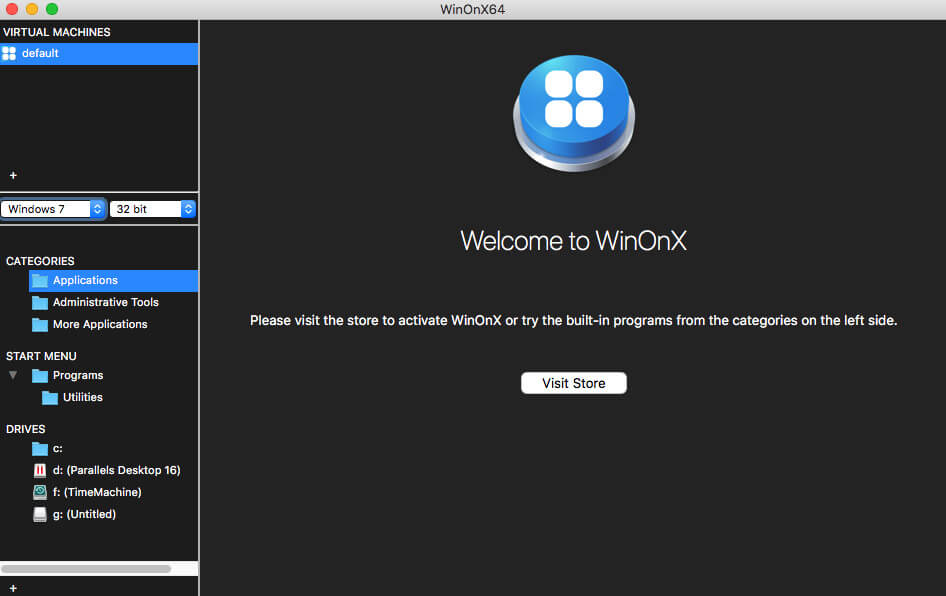
✅ Pros of WinOnX:
- The boot time for the average Mac with this emulator is only two seconds. It can be up to 30 seconds on competitive products.
- You don’t need to create a partition to operate the program.
- It provides .NET and full-screen support to make it easy to use.
⛔ Cons of WinOnX:
- It doesn’t work as well if you attempt to use a Windows-based app with a macOS version you’ve already installed.
- Not all software and apps are compatible with WinOnX because it redirects communication between the program and Windows to macOS.
- The installation process can be cumbersome.
- This tool hasn’t been updated since 2019.
We like the overall simplicity that comes with this Windows emulator for Mac. Although it could use more language support and a more straightforward installation process, it performs the tasks it is meant to do relatively well.
The app is old enough that the production team hasn’t submitted any privacy details. That issue could be somewhat concerning for some people.
It’s also only compatible with 64-bit processors and OS X 10.11 or later. Pricing starts at $9.99 for an annual subscription or a $29.99 one-time purchase.
More information about WinOnX is available through the App Store:
https://apps.apple.com/us/app/winonx-64/id421346233?ls=1&mt=12
6. Wine
Wine, coming from its original acronym meaning which is “Wine Is Not an Emulator”, is not a conventional emulator but rather a compatibility layer that enables you to run Windows applications on macOS without the need for a full Windows installation. While it provides a unique solution for running Windows software on a Mac, it comes with its own set of pros and cons.
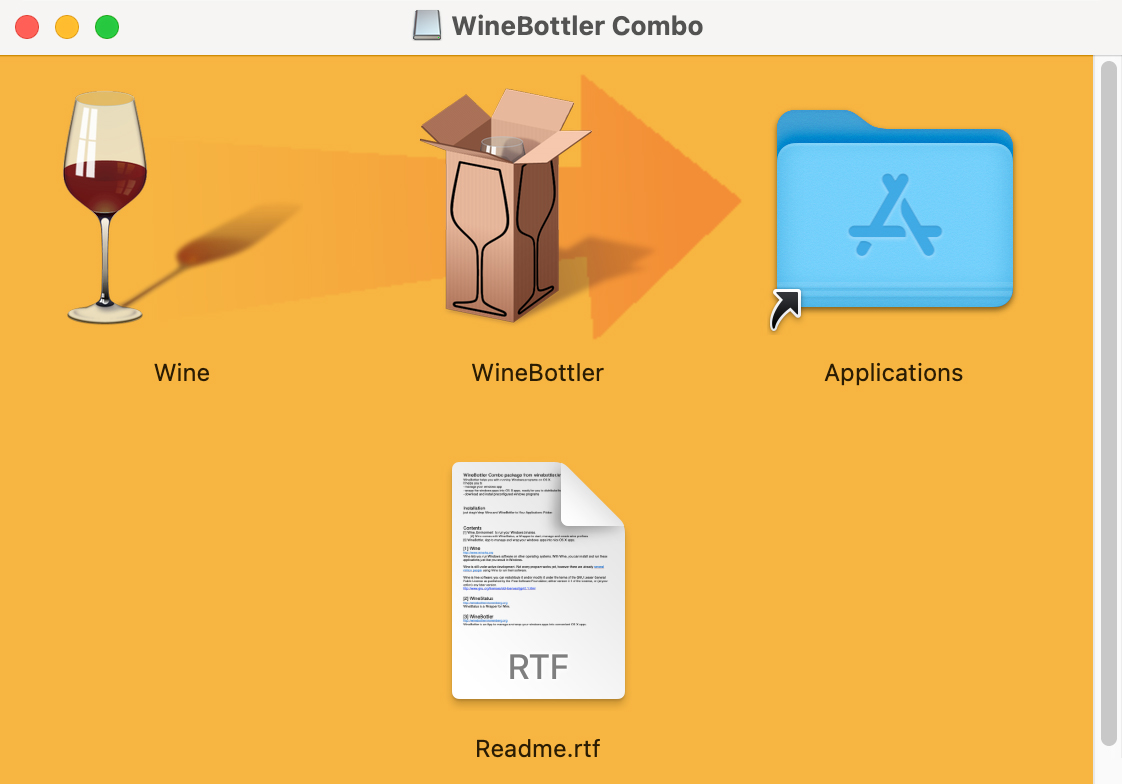
✅ Pros of Wine:
- Wine wants to make sure it can run lots of different Windows programs smoothly on a Mac.
- It’s made to be not too heavy on your computer, so it might work better and use less power.
- Wine is free, and a bunch of people work together to make it better all the time.
- You don’t need to buy a separate Windows license like you do with some other ways of running Windows on a Mac, which could save you money.
- It updates from time to time, making sure it stays current and works well with new things.
- Offers a variety of ways to get help in using Wine. Just go to the Support section on their official website.
⛔ Cons of Wine:
- While Wine can handle many programs, not all of them work perfectly. Some applications might encounter glitches, reduced performance, or may not run at all.
- Setting up Wine for certain programs can be hard, especially if you don’t know much about its settings. Some programs might need changes to work right.
- Wine might not be great with advanced graphics, so it might struggle with programs or games that need a lot of graphics power.
- Wine may not support all Windows APIs, which could affect the functionality of specific applications relying on those APIs.
- Unlike some other programs that act like Windows on a Mac, Wine might not make Windows programs fit in perfectly with the rest of your Mac.
Even though Wine has some difficulties, it’s still a useful tool for people who want a simple and free way to use certain Windows programs on their Macs. Before you start using Wine, it’s a good idea to look at its compatibility list and talk to other users in the forums to see how well the programs you want to use will work. Doing some research beforehand will help make sure everything goes smoothly and you have a good experience
Honorable Mentions: Windows Emulators for Mac
If you need a Windows 10 emulator for Mac, a few honorable mentions are worth considering if you found that the ones in this guide don’t quite meet your needs.
- Boot Camp provides a straightforward installation process, but it requires you to hold a registered and licensed copy of the Windows operating software to use the product.
- Citrix XenApp allows you to use whatever app you want on any device because it pulls information from a local database. That makes it available for offline access.
- VirtualPC for Mac is more expensive ($129) than most programs in this category, but it delivers a comprehensive name-brand solution. It works will all macOS versions with simple sharing options between the host and virtual session.
- CrossOver Mac lets you start Windows apps from your Mac without a virtual environment. Once you install the program, you’re ready to boot up whatever you need.
In Conclusion: Finding the Best Windows Emulator for Mac
When you need a Windows PC emulator for Mac, several solutions are available online to find. It is up to you to determine how safe they are and if your information stays private.
Although these options provide comprehensive resources for almost any need, there isn’t one go-to solution that everyone should use. That’s why reviewing each platform is an essential part of this process.
You don’t need to have a Windows PC and a Mac to stay productive today. When you’ve got the right emulator, you can accomplish virtually anything!
Post Views: 1,621
